Below is an essay on Iain Macnab. Someone who is talked about for his and Claude Flight’s Grosvenor School. I didn’t really know a lot about Macnab but the text and illustrations are from The Artist, April 1937.
The old adage that “Those that can, do; those that can’t, teach” is one of those half-truths that are dangerous from their very speciousness. It is a good thing to dissect and expose them once in a while. So far as the fine arts are concerned, one need not look far for examples to prove the frequent falsity of this cruel and facile allegation.
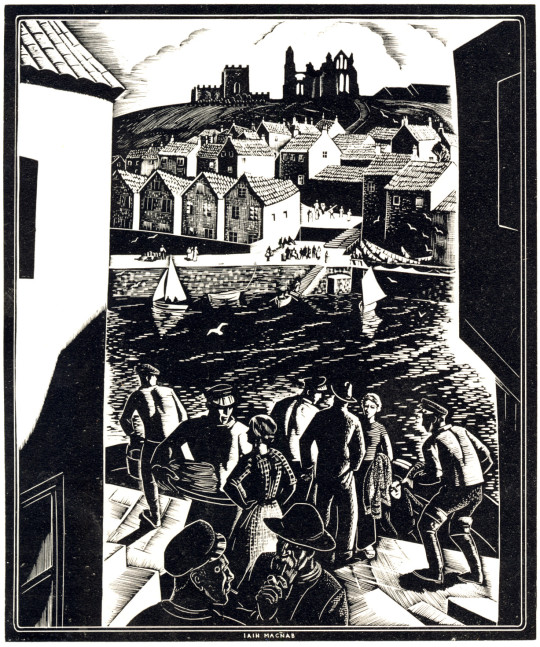
Iain Macnab – LNER Poster
Sickert is one conspicuous case; Tonks (whose recent loss we mourn) is another; and among the younger men one could hardly select a better subject than lain Macnab, who can both ‘do’ and ‘teach’ with talent and finish, and who is an artist teacher because he has the two-fold vocation.
The clarity of his exposition, the whole-hearted enthusiasm with which he descants on art, the breadth and catholicity of his views, mark him out a born teacher; while his own production as a painter and engraver is proof of his capacity as a practising artist.
Macnab is of Highland ancestry, and comes of an ancient and celebrated line of Scottish armourers, the Macnabs of Barachastalain. He has always found his hand respond easily to any new technique, and he is inclined to attribute this manual aptitude to the ingrained hereditary habit produced by an age-long tradition of fine engraved work on pistols and other arms. Also, there were artists on both sides of his family. His father was in the Hong Kong & Shanghai Bank, and Macnab was born on 21st October, 1890, at Iloilo, in the Philippine Islands, which were then under Spanish control. He lisped in Spanish as an infant but at the age of four he was brought home to Kilmalcolm, in Renfrewshire.
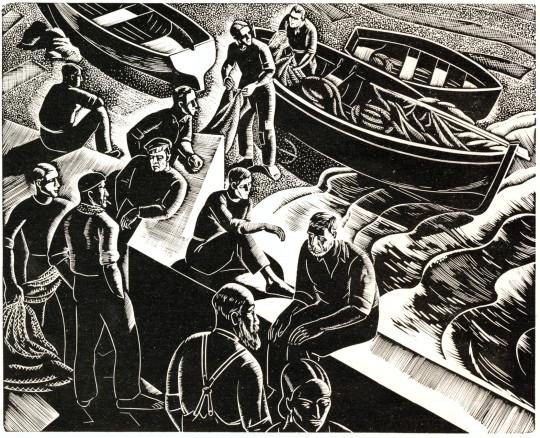
Iain Macnab – Fisherman at Portofino, 1937
During a holiday in Ireland at the age of seven a gypsy foretold that he would become an artist. He was educated at Merchiston and left school at eighteen. Already as a boy his interests were turned to sculpture, painting and cartooning, with the first perhaps pre-eminent, but the career chosen for him was that of chartered accountant, and he duly served his artiles thereto in Glasgow for five and a half years. He was due to sit for his final examination in October, 1914; with the prospect if he passed, of an excellent post in the Philippines, leading to the early reversion of a complete business.
But the outbreak of the war formed a pretext for abandoning accountancy, and Macnab enlisted at once as a private in the Highland Light Infantry. Being already trained in the school cadet corps, he found himself in France by the end of October, 1914 and is a Mons Star man. In April, 1915 he was granted a regular commission in the 2nd Argyll and Sutherland Highlanders. During the battle of Loos he was blown up by a shell. After some little time symptoms of grave internal injury became evident; and in July, 1916 he was invalided out of the service.
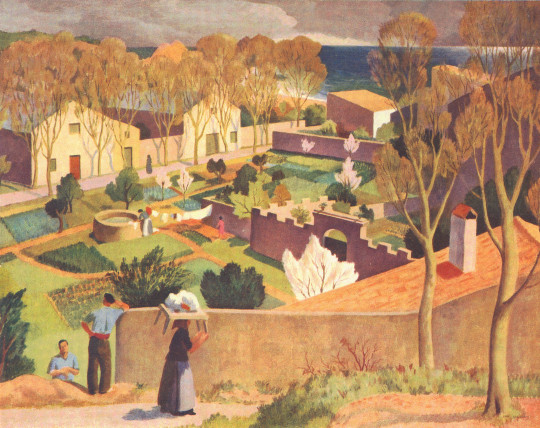
Iain Macnab – Spring Landscape, Tossa, 1936
His cure was by no means complete, however, and it was not until 1918 that he was well enough to take the art course he had promised himself.
In that year he became a student at Heatherley’s. He had already seen and studied many good paintings; he had an uncle who knew several of the Impressionists, and who used to talk art with him; and in general his mind was well stored with paintings lore. He started work with the determination to be a professional artist or nothing; the amateur status had no attraction for him. His rapid progress, his fertility in ideas, and his clear and ready exposition of them, led Henry Massey, the Principal of the School, to see in him a potentially valuable teacher. So strongly did Massey feel this that after only a year he offered Macnab the post of joint Principal of Heatherley’s.
With this offer Macnab closed, and as a teacher worked with enthusiasm at the School till temporarily put out of action again, in 1925, by a too-vigorous pull at the etching press. While convalescent in a nursing home he decided that the time had come when he needed, for the proper expression of his educational theories, a school under his sole personal control; so, once well again he found a big house in Warwick Square, Belgravia, and on 19th October, 1925 opened there the Grosvenor School of Modern Art.
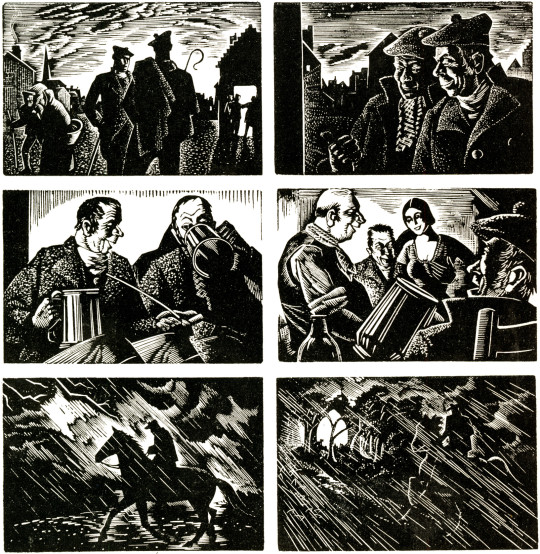
Iain Macnab – Illustrations for Burns’s Tam o’Shanter, 1934
Macnab had thought out the broad principles on which he wished to run his school. His idea was not so much to train students to paint what they saw, in the crude sense, as to teach them to isolate from nature the elements that are truly pictorial, and then to develop their own personalities. His ambition was to make artists.
To be an artist, as distinguished from a mere competent draughtsman, he felt, it is necessary first to have a personality to express. It is indispensable to the production of a work of art that an emotional reaction shall take place. Of that reaction the drawing is only a vehicle. He stresses the cardinal importance of composition; the students are encouraged to approach every problem in terms of design from the beginning, and to build up their drawings gradually on logical principles.
The preliminary visualisation of a subject in planes and its resolution by successive steps into a picture giving the illusion of three-dimensional form are clearly expounded in his recent book on ‘Figure Drawing.’ He is a firm believer in the virtues of wood-engraving as a discipline for all artists, since in this medium every mark must have its significance, and the whole thing must be thought out thoroughly in advance, for there is no scope for fumbling or retouching.
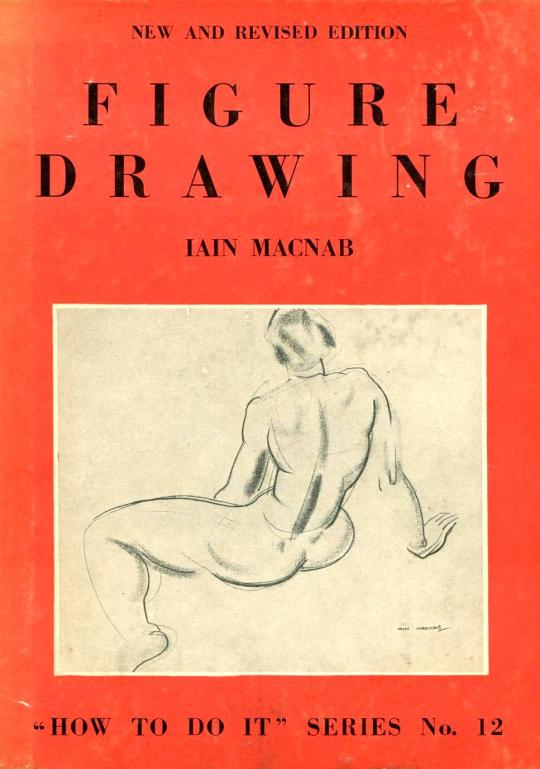
Iain Macnab – Figure Drawing, 1936
Macnab considers himself lucky to have attracted, from the first, a serious-minded type of student, took kindly to his inexorable rule of silence while at work in the studio. This rule shows his common sense, and is by no means the mark of the martinet. No one, indeed, could be less like the more starched kind of pedagogue than Macnab; and when the time comes for exposition and discussion he not only admits but encourages the criticisms of students.
He believes in the thorough ventilation of the subject, and strives to train his pupils to see the inwardness of widely-differing styles. Side by side with his teaching activities Macnab has pursued a versatile course as an artist. He began painting in 1918, and has developed, both in oils and water-colours, a distinctive style that, while it has nothing outré about it, is thoroughly in the modern trend of design.
In October, 1922 he decided that he would like to etch. He was told of five-year courses and suchlike, but this did not suit him, so he bought copper, tools, acid and a book on etching, and within three months had produced six prints which were good enough to secure his election as an Associate of the Royal Society of Painter-Etchers. For some years he exhibited etchings at the Academy, but in 1929 he decided that the copper was altogether too facile and deserted it for wood engraving.
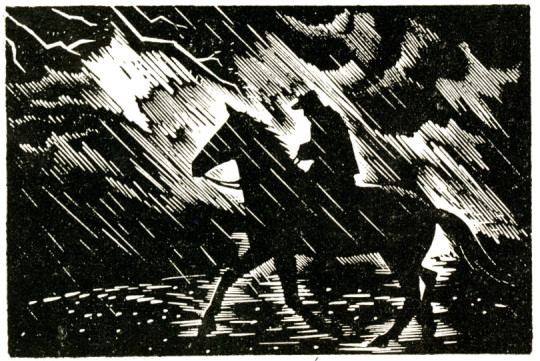
Iain Macnab – Illustration from Burns’s Tam o’Shanter, 1934
This medium he took up largely because of its recalcitrance, because of the stern discipline it imposes. In it he has done some of his finest work; and one might go a long way before finding wood-engravings to equal the ‘Tam of Shanter’ illustrations here Shown, with their beautiful distribution of blacks and whites and their admirable translation of the famous story into graphic terms.
Macnab is a member of the Royal Institute of Oil Painters, Honorary Treasurer of the National Society, and was made a full R.E. in 1935. He has held only one one-man Show, at the old Albany Gallery, Sackville Street. He exhibits each year at the Royal Scottish Academy, and frequently at the London Group, the Royal Institute of Oil Painters, the New English Art Club and the National Society. He has achieved much, and much more may be expected from him in the future.